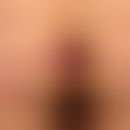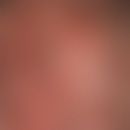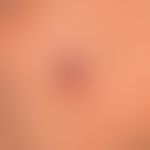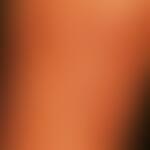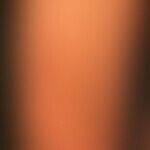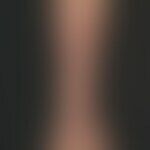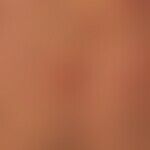Synonym(s)
DefinitionThis section has been translated automatically.
Purulent or non-purulent inflammation of the hair follicle.
On the one hand, folliculitides are differentiated according to the stage and acuteity of the follicular inflammation; on the other hand, the clinical picture is decisively influenced by the affected body region. A very superficial folliculitis is called ostiofolliculitis. In the case of deep folliculitis (folliculitis profunda-furuncle/carbuncle) there is a risk of follicle destruction and spread of the inflammation to the surrounding area (purulent perifolliculitis).
Folliculitis can be of bacterial, mycotic or parasitic origin (the most common pathogens are Staphylococcus aureus, more rarely gram-negative germs, dermatophytes, Candida species or Demodex folliculorum).
Non-purulent folliculitides occur in chronic cornification disorders of the hair follicle (follicular keratoses) or in hair growth disorders, furthermore as drug reactions or vitamin deficiencies.
In a number of follicular inflammations (e.g. pustular eosinophilic folliculitis) the cause is completely unknown.
ClassificationThis section has been translated automatically.
In the present overview, follicular-associated inflammations are listed, some of which are referred to as "folliculitis" or "folliculitis", but also under other terms that do not suggest a connection to folliculitis. The diseases of the "acne vulgaris complex" are not listed. Folliculitis can also be divided according to the level on which it occurs, into superficial and deep folliculitis.
I. Infectious folliculitis
-
Fungal
- Dermatophyte folliculitis (see below Tinea corporis)
- Pityrosporum folliculitis
- Infantpityrosporum folliculitis
- folliculitis barbae candidamycetica
-
Bacterial
- Staphylococci/Streptococci (see below follicular pyoderma)
- Superficial folliculitis (in common parlance not prejudicially called folliculitis, colloquially called pimples)
- Round folliculitis
- Boils: deep melting folliculitis with perifolliculitis
- Carbuncles: confluent melting profound folliculitis
- Folliculitis barbae
- Folliculitis in perioral dermatitis
- Other bacteria
-
Viral
- Herpes simplex Folliculitis
-
Parasites
- Demodex folliculitis (demodicosis)
II. follicular cornification/hair growth disorders
- Follicular ichthyosis (between ichthosis vulgaris and keratosis follicularis)
- folliculitis decalvans
- Folliculitis granulomatosa perforans
- Pseudofolliculitis barbae (Sycosis barbae)
- Folliculitis sclerotisans nuchae (Acne keloidalis)
- folliculitis ulerythematosa reticulata
- Ulerythema ophryogenes
- keratosis pilaris
- Lichen spinulosus (Keratosis spinulosa)
- pityriasis rubra pilaris
- follicular perniosis
III. chemical/physical induced folliculitis
-
Drugs
- Drug induced folliculitis (e.g. Bromoderm)
- Steroid acne
- Acneiform folliculitis due to tyrosine kinase inhibitors
-
External irritants
- Tar and oil acne
- Shave folliculitis (shaving - lower leg - induced mechanical folliculitis)
IV. Idiopathic folliculitis
- Folliculitis eosinophilic pustular (eosinophilic folliculitis)
- Eosinophilic folliculitis in childhood
- Dermatitis erosive pustular of the capillitium
- AIDS related eosinophilic folliculitis
- erythromelanosis follicularis faciei et colli
- follicular mucinosis
- Acne Mallorca Acne
- Folliculitis necrotizing lymphocytes
- Folliculitis, perforating
- lichen planus follicularis
- Lupus miliaris disseminatus faciei
- lupoid rosacea
- Follicular eczema/follicular psoriasis
V. Other folliculitides
- Phrynoderm
- Follicular mycosis fungoides (see also Mucinosis follicularis)
TherapyThis section has been translated automatically.
According to the individual clinical pictures.
LiteratureThis section has been translated automatically.
- Laureano AC et al (2014) Facial bacterial infections: folliculitis. Clin Dermatol 32:711-714
- Sardana K (2014) Follicular disorders of the face. Clin Dermatol 32:839-872
- Vañó-Galván S et al (2015) Folliculitis decalvans: a multicentre review of 82 patients. J Eur Acad Dermatol Venereol doi: 10.1111/jdv.12993.
Incoming links (35)
Acne keloidalis nuchae; Acrodermatitis enteropathica; Boils; Candida folliculitis; Demodex folliculitis; Dermatitis cruris pustulosa et atrophicans; Ekthyma; Fibreglass dermatitis; Fistula, odontogenic; Folliculitis; ... Show allOutgoing links (44)
Acne inversa; Acne keloidalis nuchae; Boils; Bromoderm; Candida; Candida folliculitis; Carbuncle; Demodex folliculitis; Dermatophytes; Eosinophilic pustular folliculitis; ... Show allDisclaimer
Please ask your physician for a reliable diagnosis. This website is only meant as a reference.
